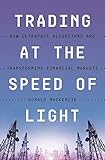Trading at the speed of light : how ultrafast algorithms are transforming financial markets / Donald MacKenzie.
By: MacKenzie, Donald A [author.] .
.
Material type:  BookPublisher: Princeton, New Jersey : Princeton University Press, [2021]Description: 1 online resource (xii, 282 pages) : illustrations.Content type: text Media type: computer Carrier type: online resourceISBN: 0691217793; 9780691217796.Subject(s): Investments -- Data processing
BookPublisher: Princeton, New Jersey : Princeton University Press, [2021]Description: 1 online resource (xii, 282 pages) : illustrations.Content type: text Media type: computer Carrier type: online resourceISBN: 0691217793; 9780691217796.Subject(s): Investments -- Data processingIncludes bibliographical references and index.
"Trading at the Speed of Light tells the story of how many of our most important financial markets have transformed from physical trading floors on which human beings trade face-to-face, into electronic systems within which computer algorithms trade with each other. Tracing the emergence of ultrafast, automated, high-frequency trading (HFT) since the early 2000s, Donald MacKenzie draws particular attention to the importance of what he deems the 'material political economy' of twenty-first century finance. Fast transmission of price data used to involve fibre-optic cables, but the strands in such cables are made of materials (usually a specialised form of glass) which slow light down to around two-thirds of its speed in free space. By contrast, microwave and other wireless signals used in HFT travel through the atmosphere at nearly full light speed. At these nanosecond speeds, the physical nature of information transmission and the precise spatial location of the equipment involved become hugely important, thus creating inevitable pinch points in the system. MacKenzie details the ways in which these pinch points - individual frequency bands, specific locations on the roofs of computer data centres, and particular sites for microwave towers - are especially advantageous, making it possible for those who control them to profit from that control. The book draws from over 300 interviews conducted with high-frequency traders around the world, the people who supply them with technological systems and communication links, exchange staff and regulators, as well as with others who function within markets that have not yet become dominated by HFT. MacKenzie focuses most closely upon the four main sites of international HFT - Chicago, New York, Amsterdam, and London - and examines both the technology and the politics underpinning modern financial markets"-- Provided by publisher.
Cover -- Contents -- List of Illustrations -- Acknowledgments -- 1. Introduction -- 2. To the Towers -- 3. "We'll show you our book. Why won't they?" -- 4. Dealers, Clients, and the Politics of Market Structure -- 5. "Not only would I lose my job, I might lose my legs too!" -- 6. How HFT Algorithms Interact, and How Exchanges Seek to Influence It -- 7. Conclusion -- Appendix: A Note on the Literature on HFT -- Notes -- References -- Index
Description based on online resource; title from digital title page (viewed on May 19, 2021).
IEEE IEEE Xplore Princeton University Press eBooks Library


There are no comments for this item.